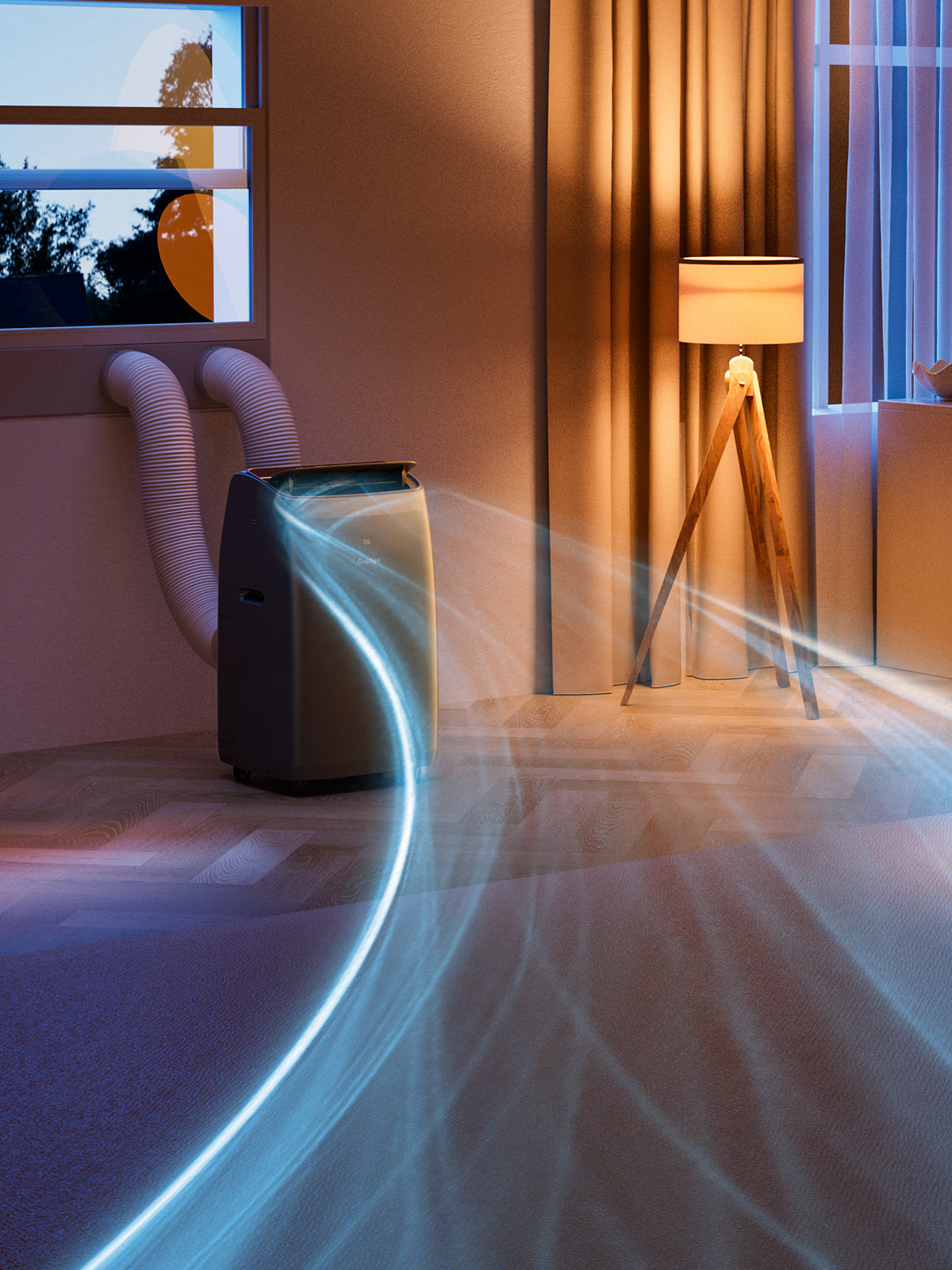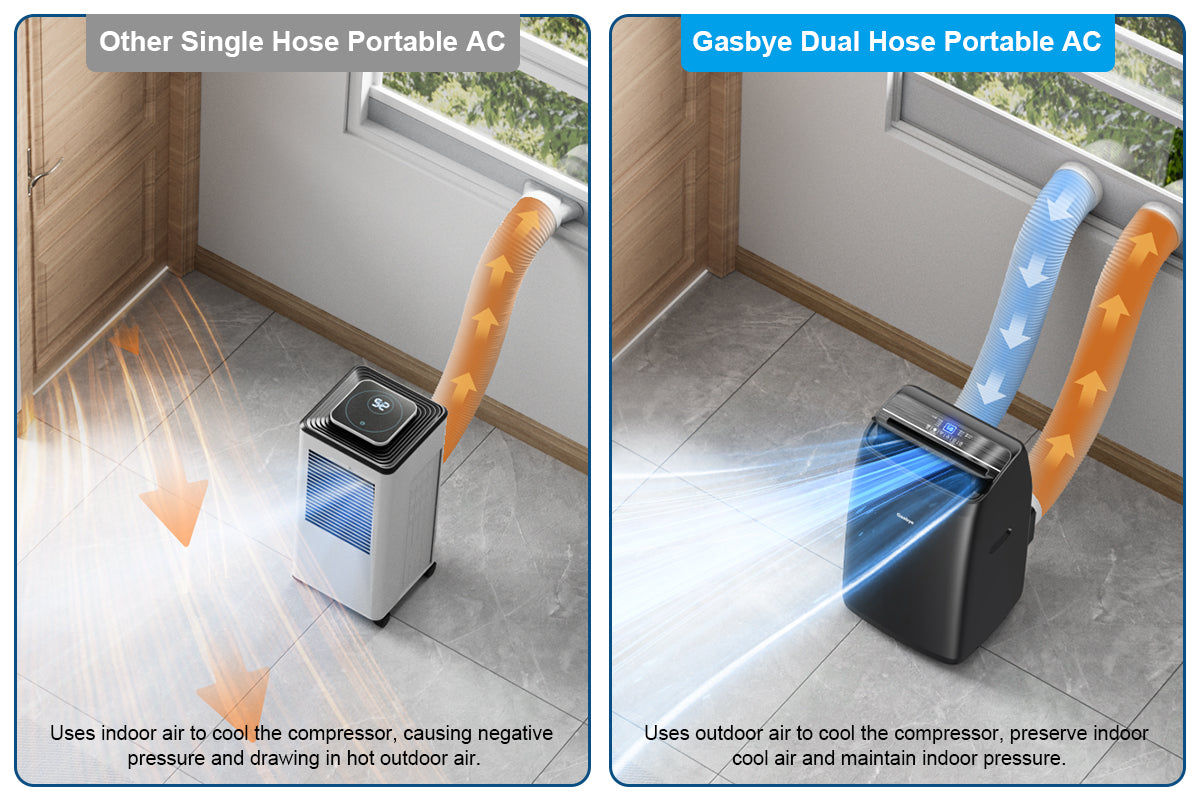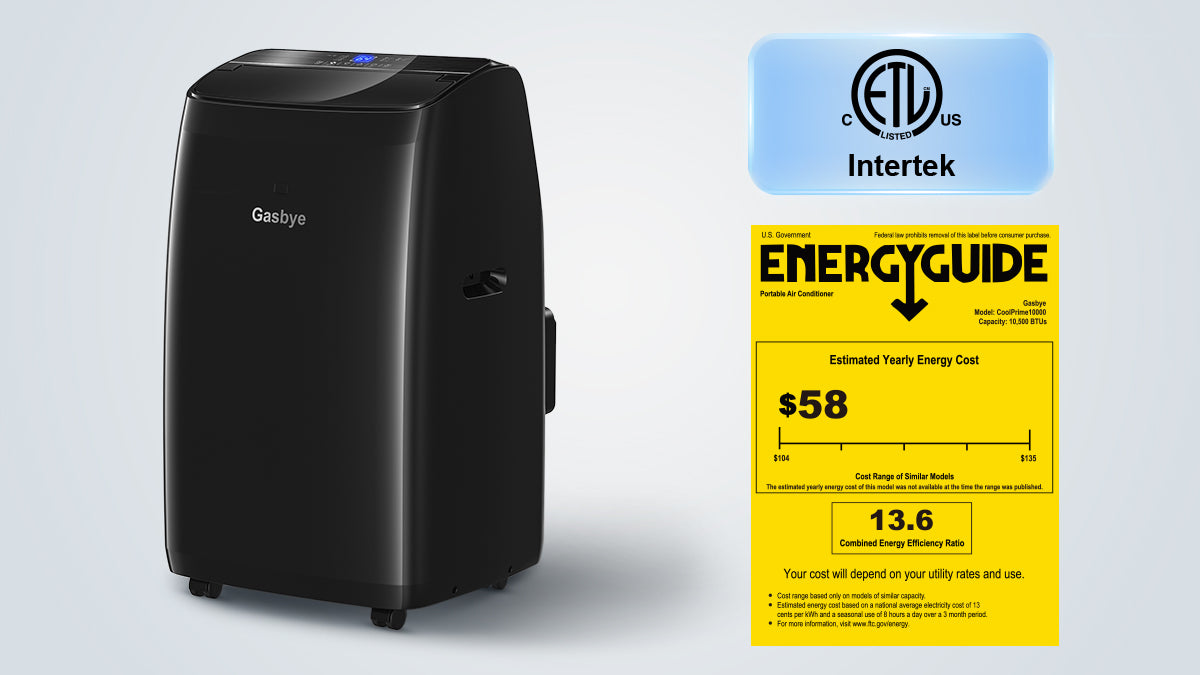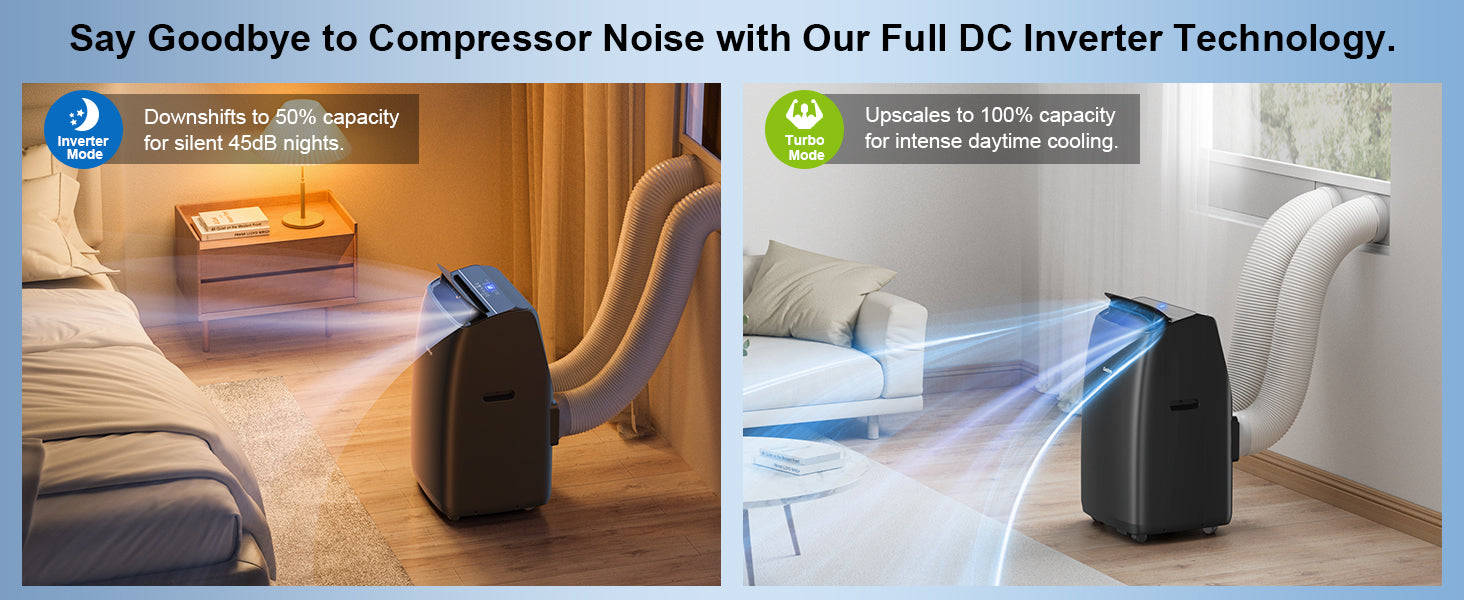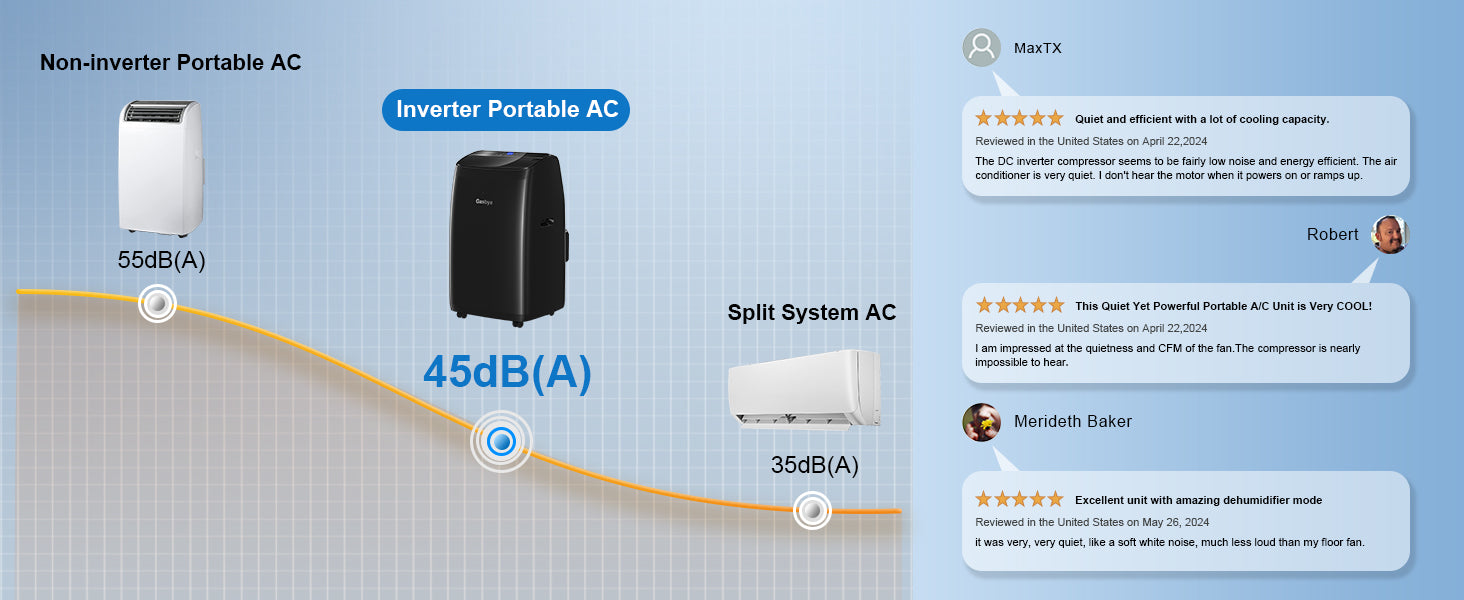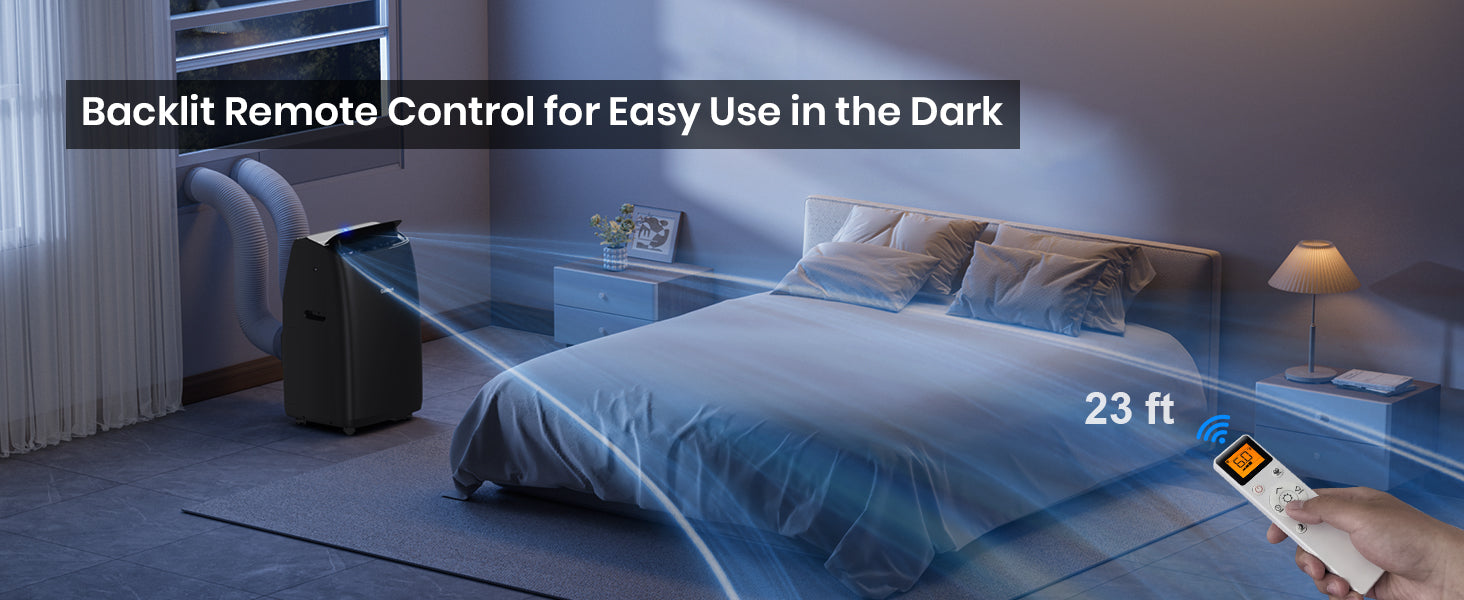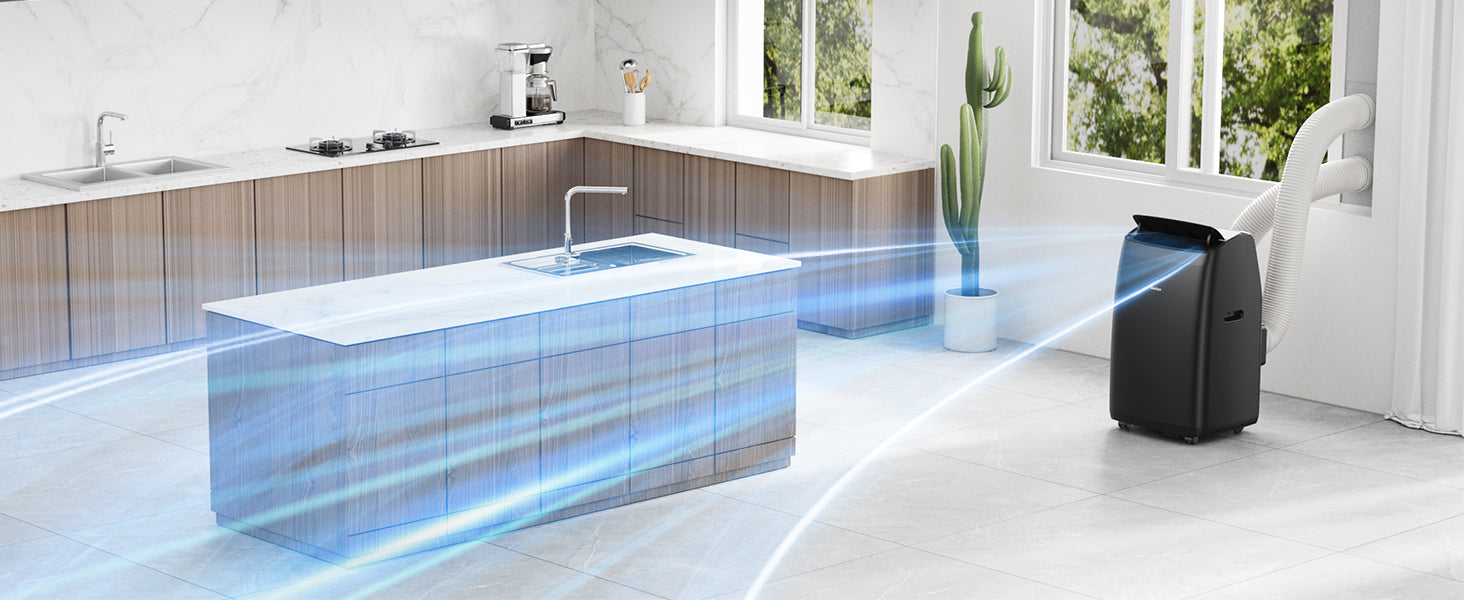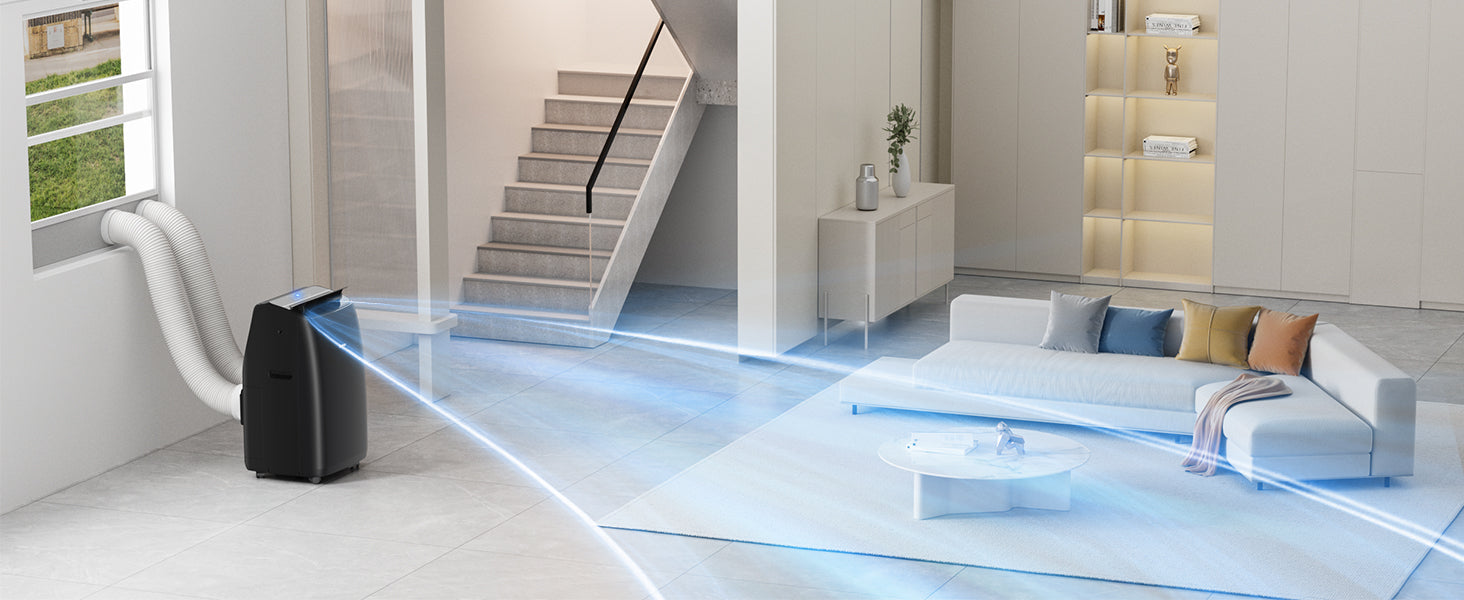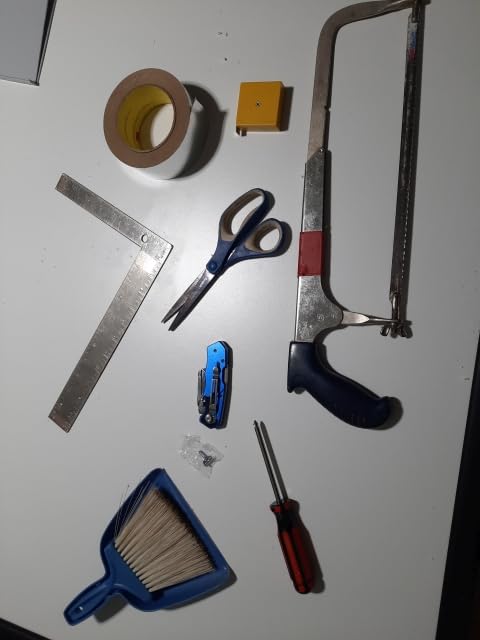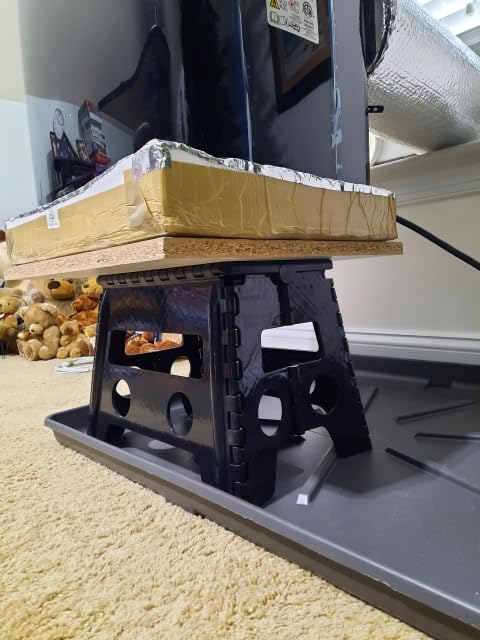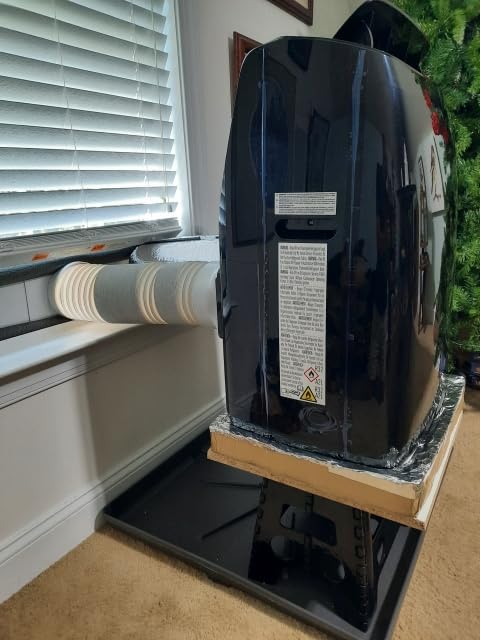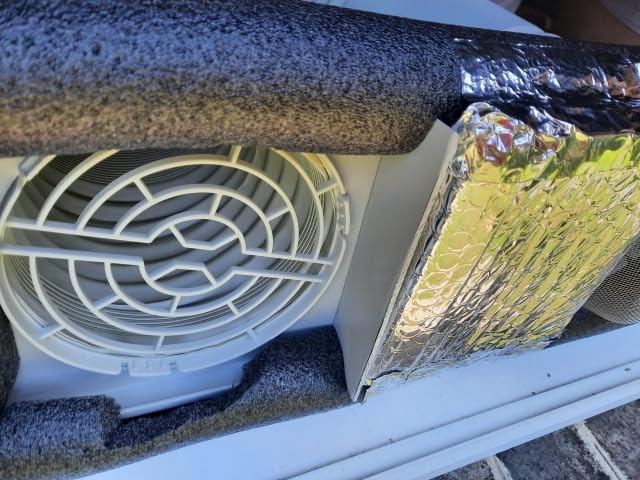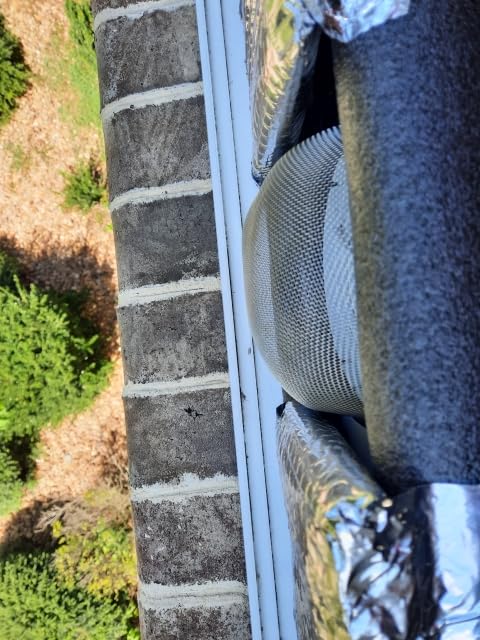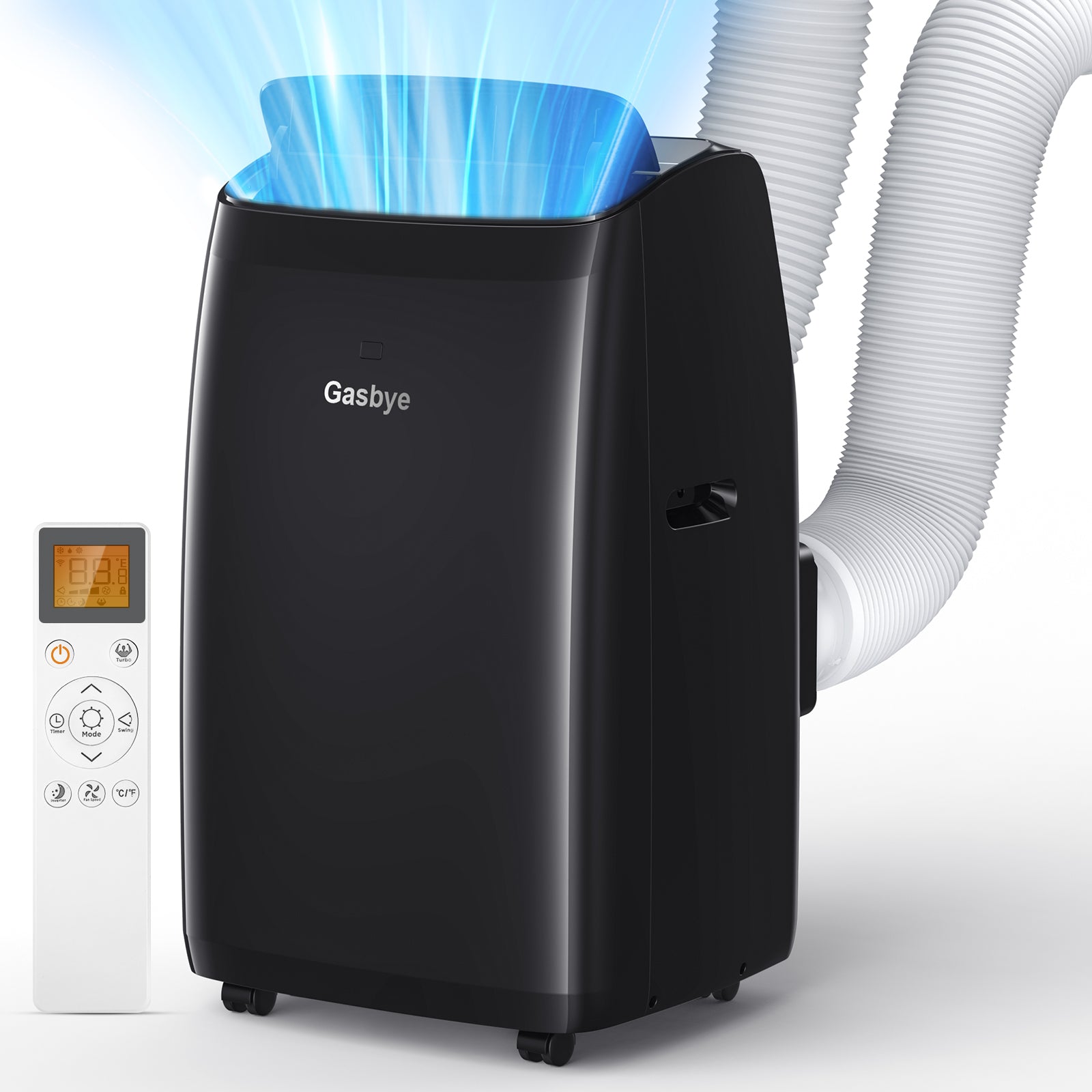
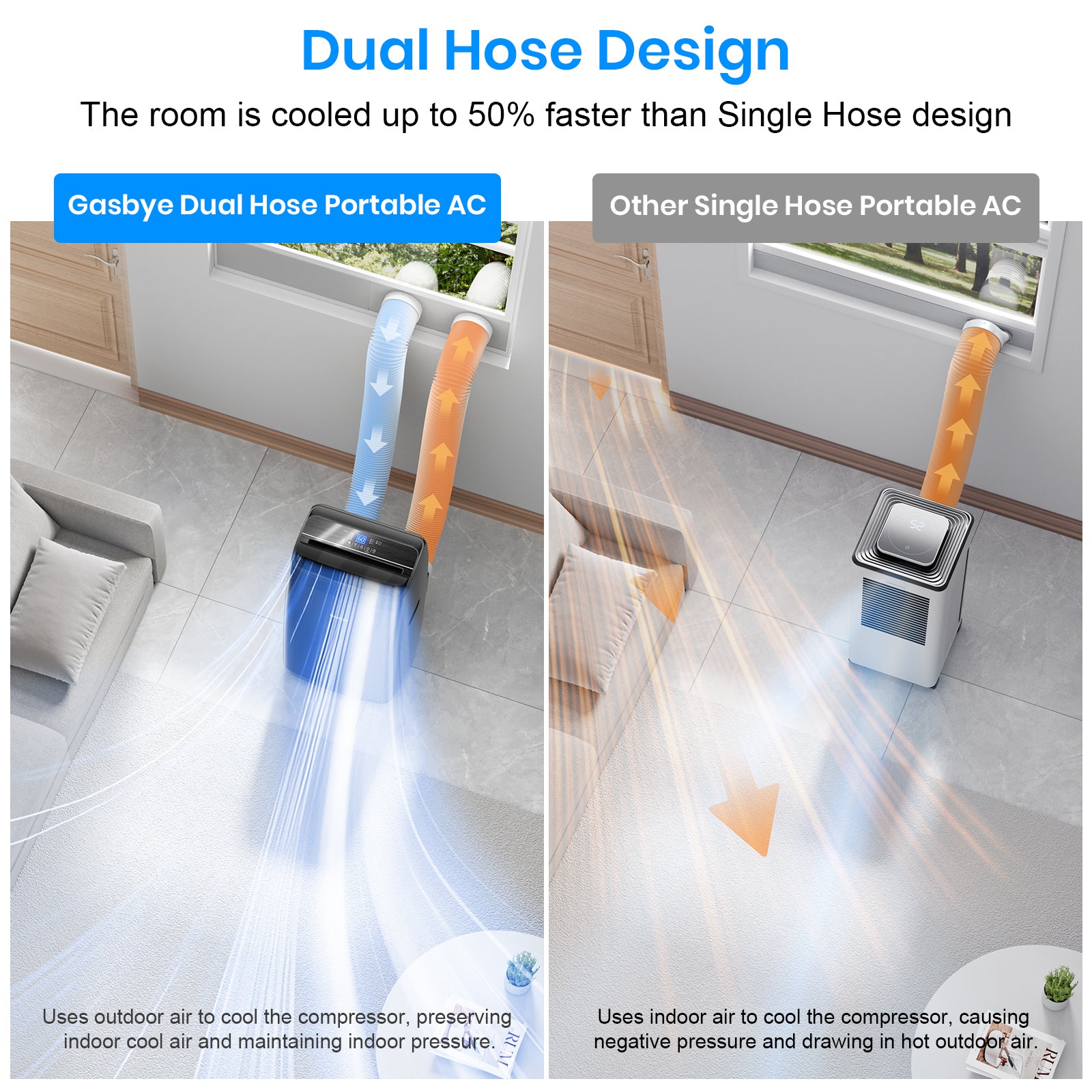
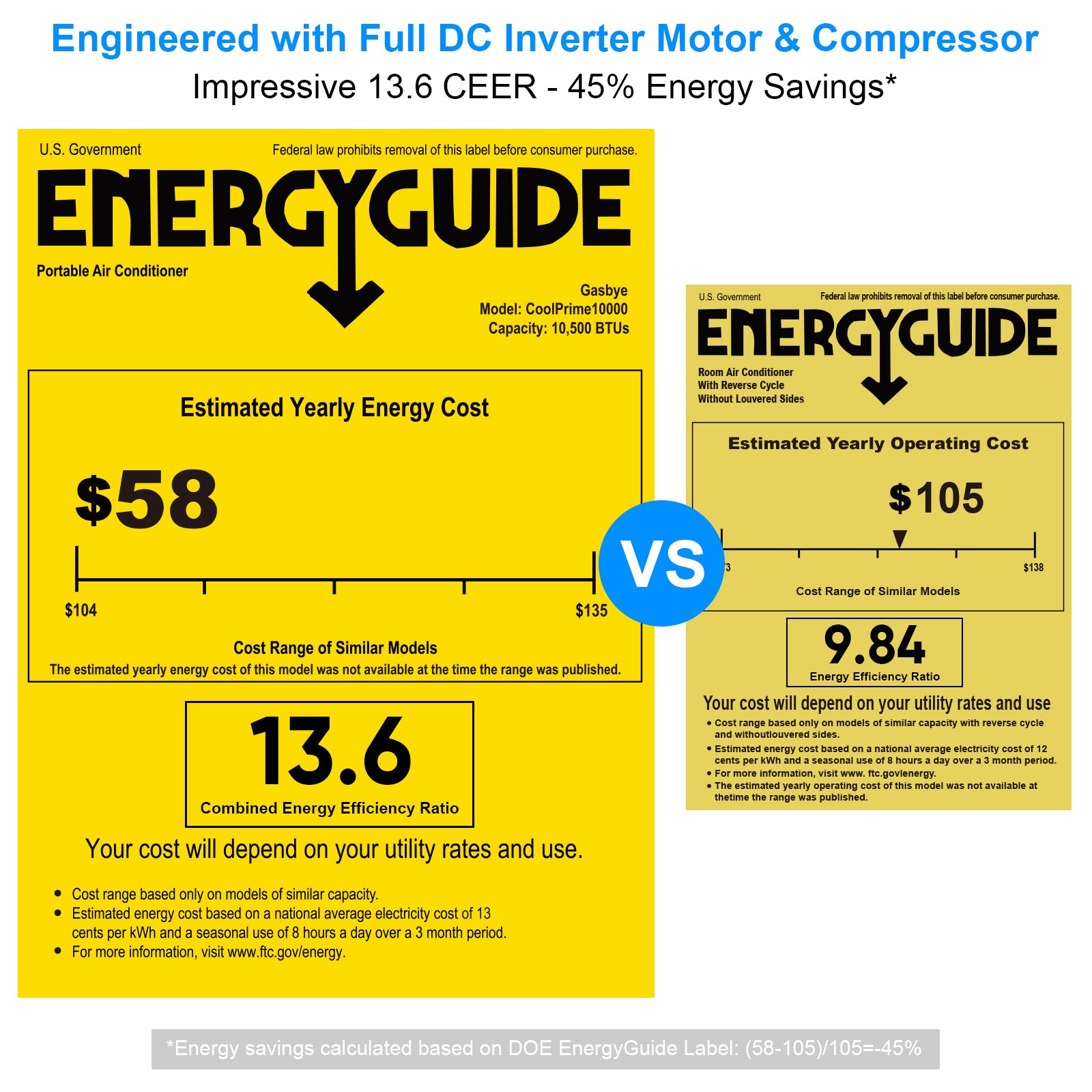
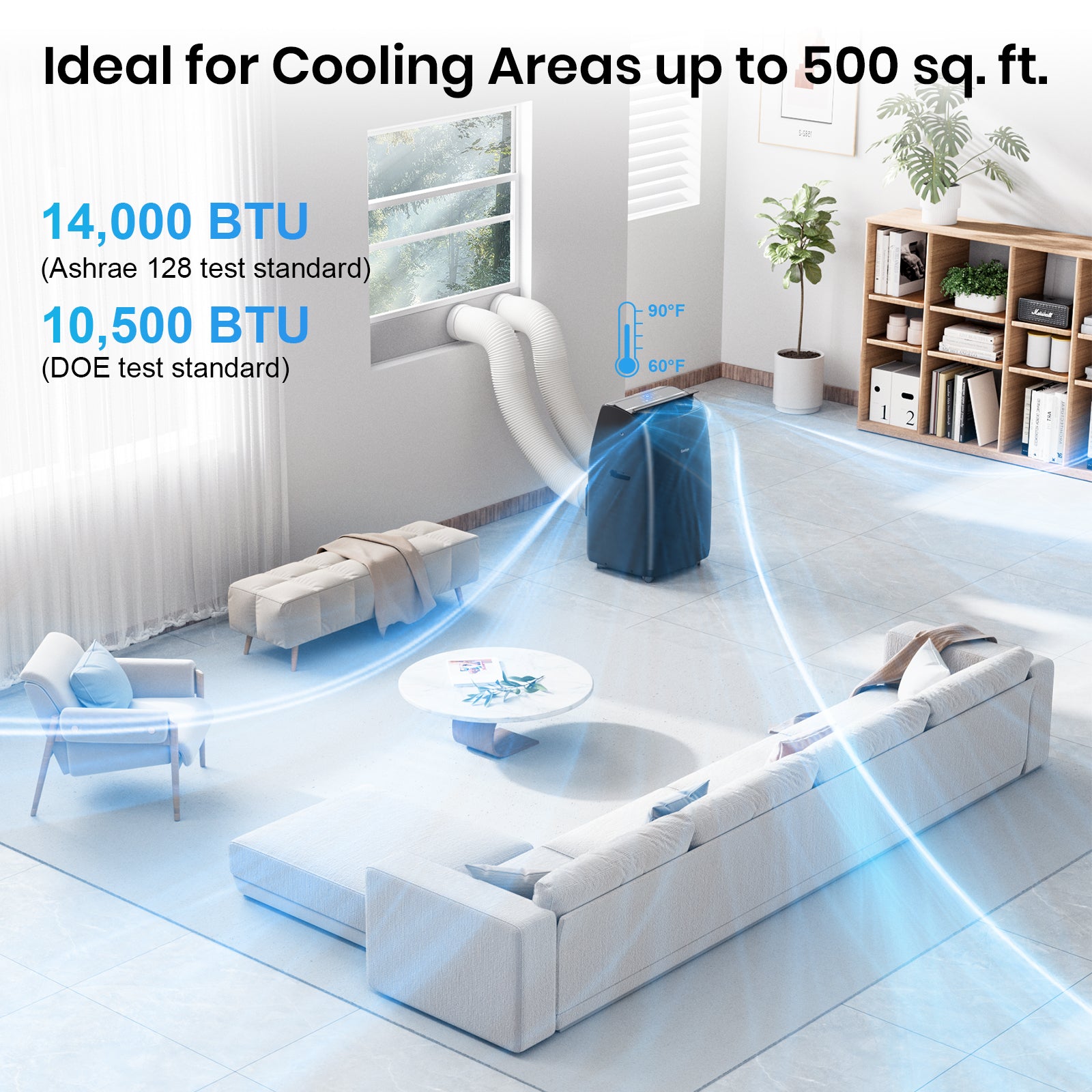
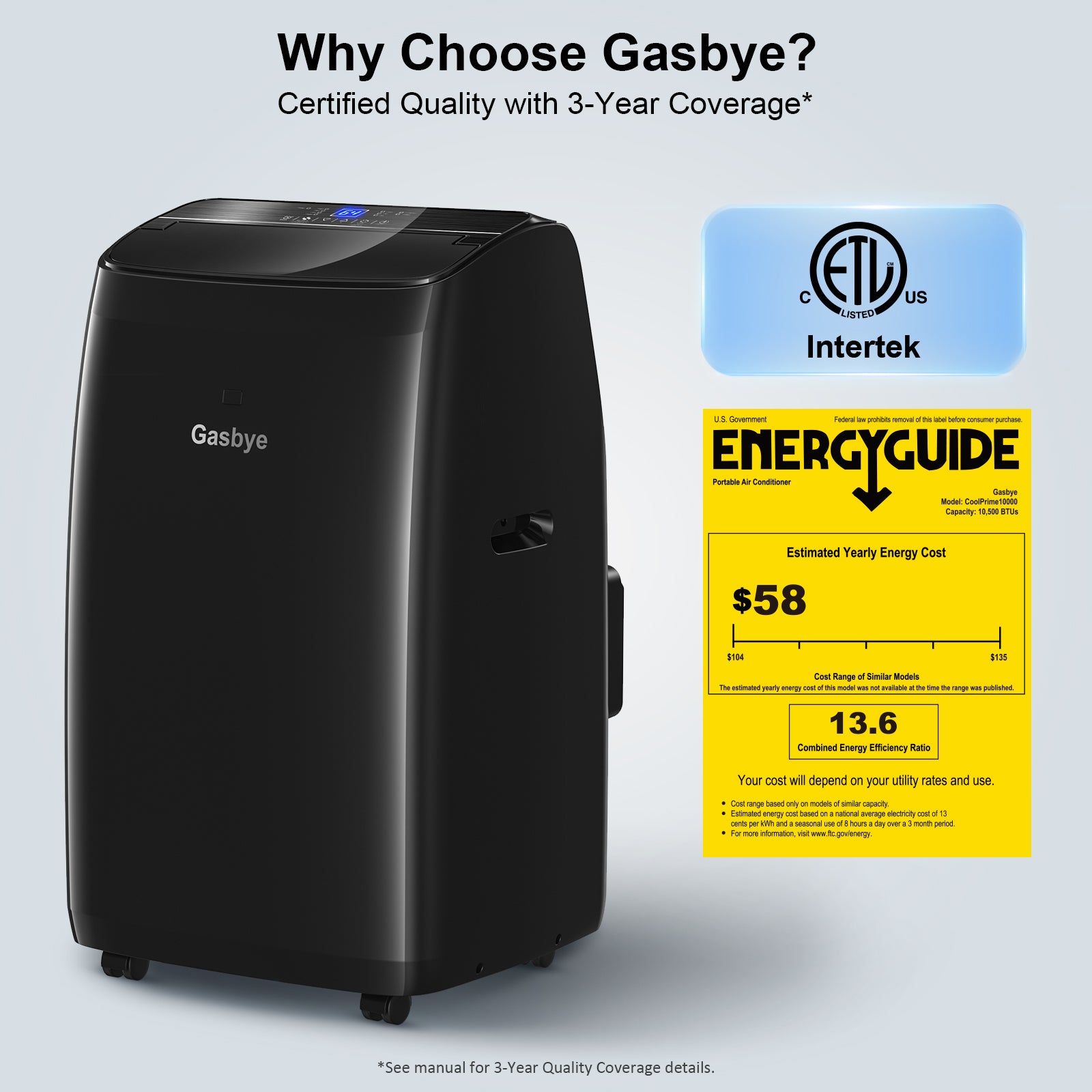
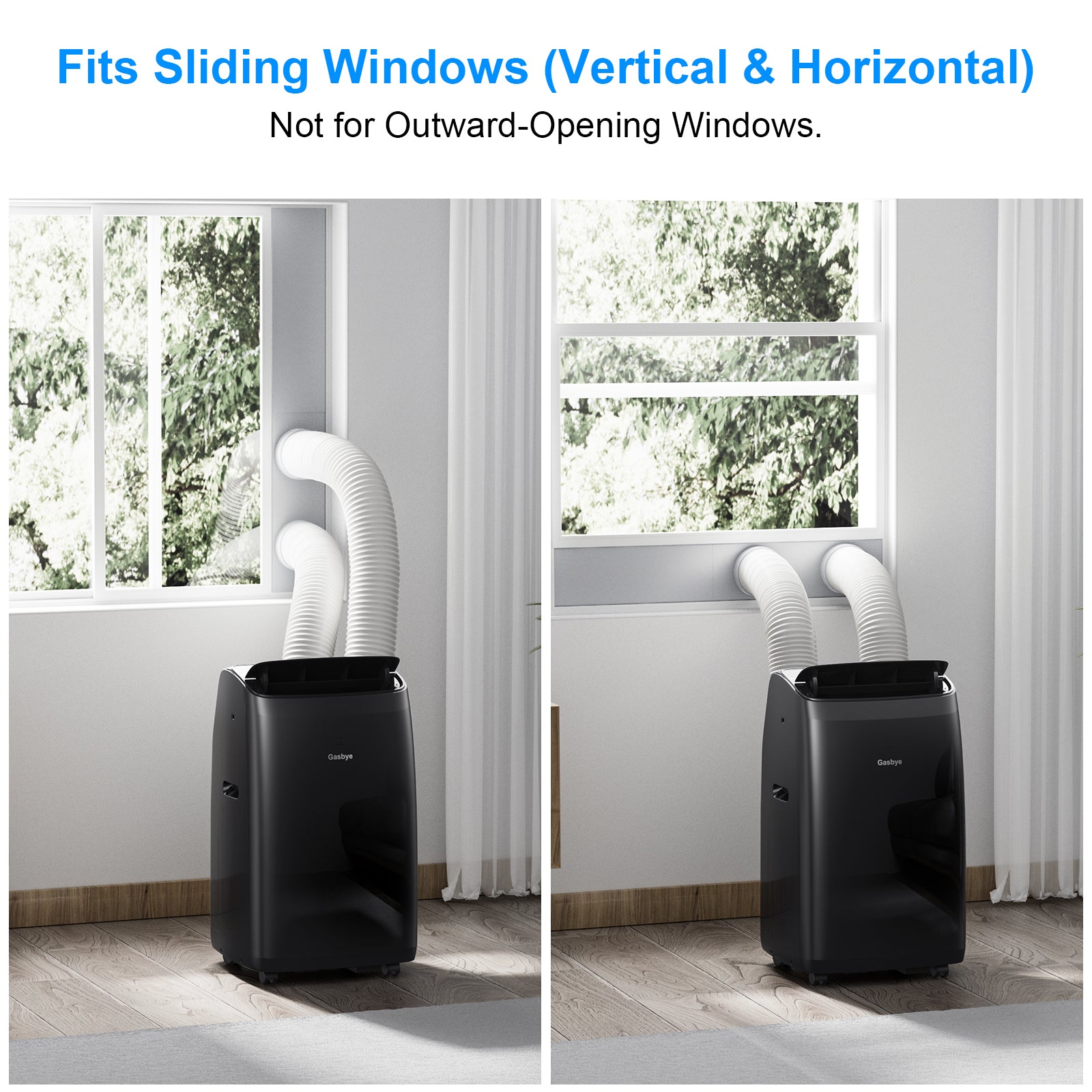
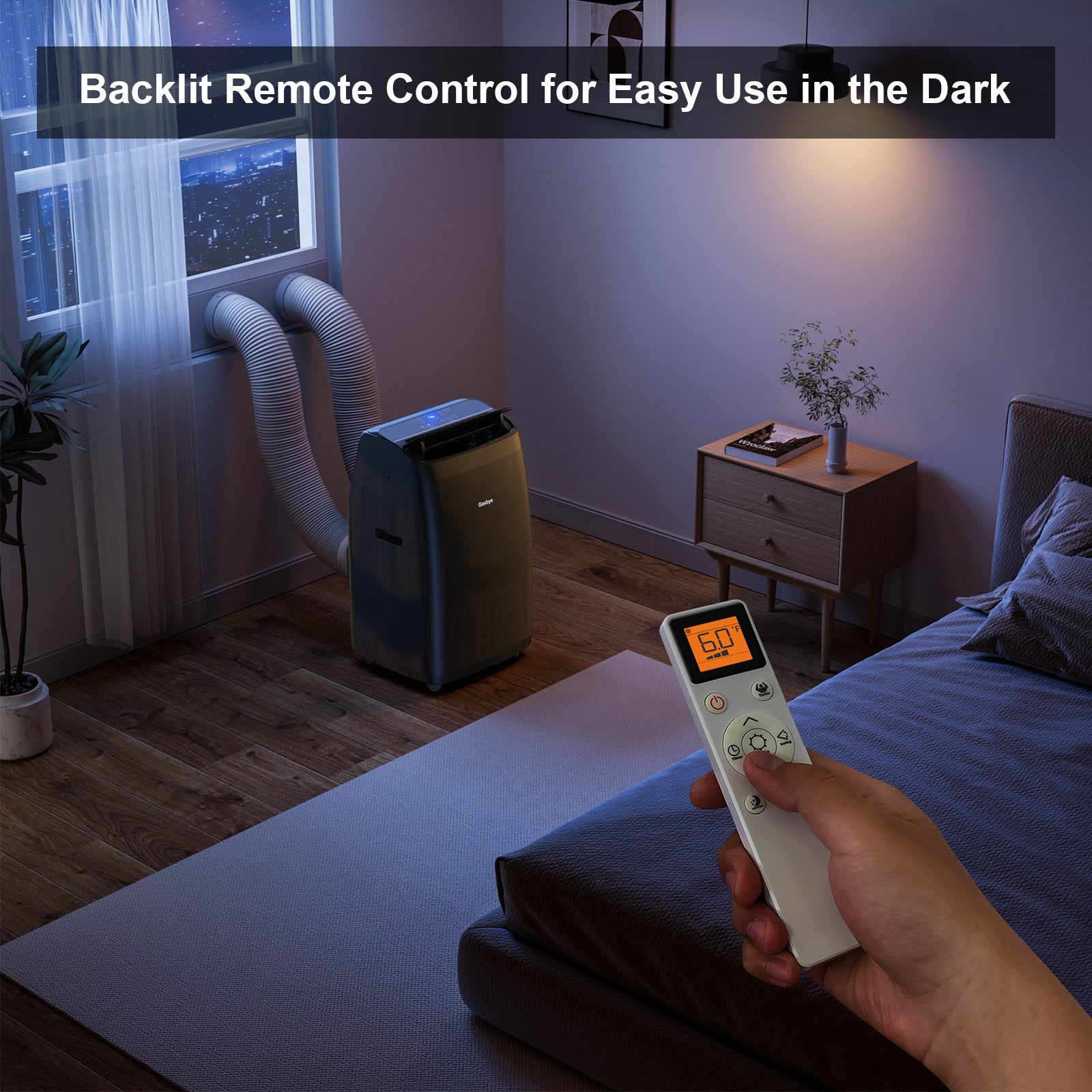
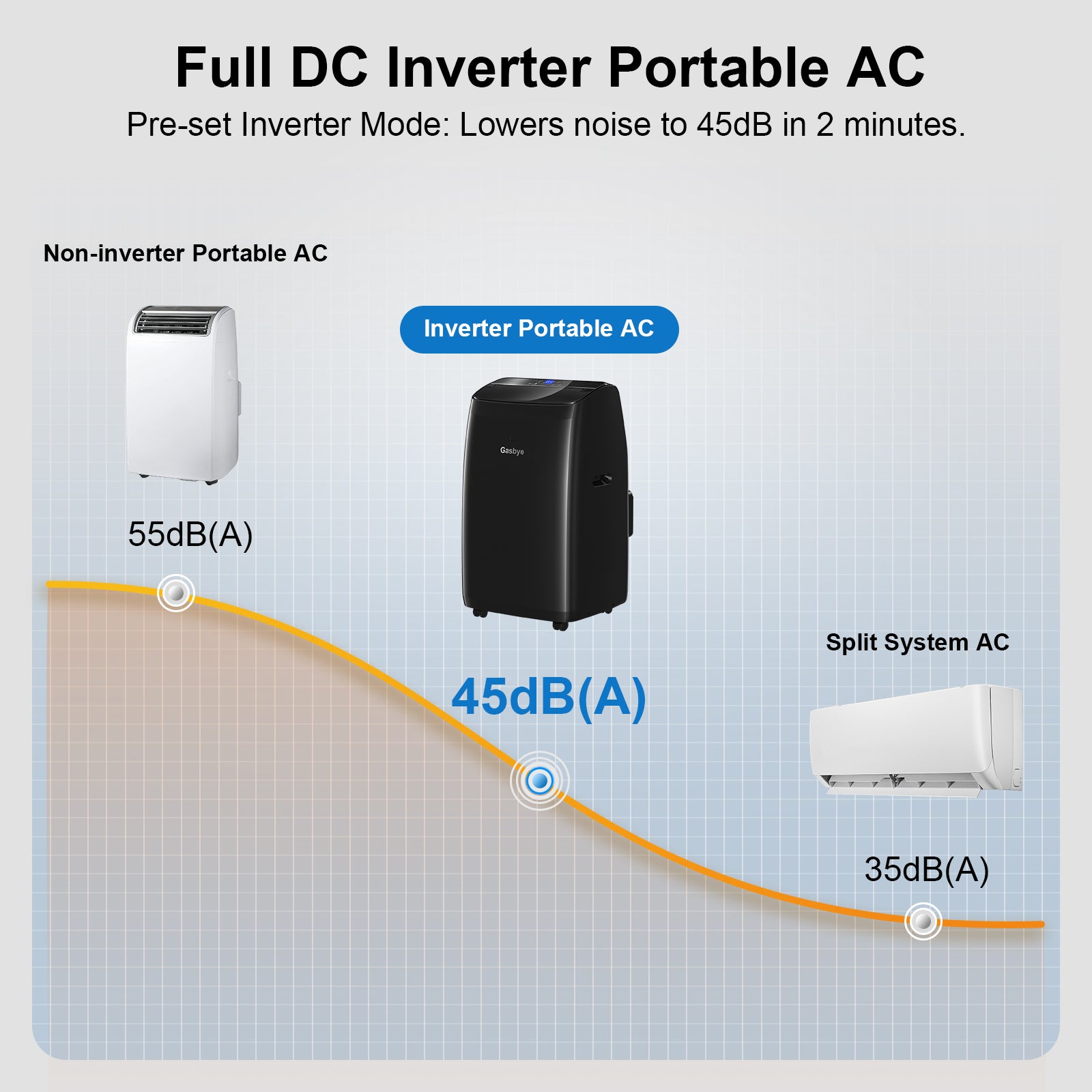
CoolPrime 10000 Highlights
Ashare 128 Standard
Cool Room Size
Energy-Saving
Reduce noise in 2 min
Gasbye CoolPrime 10000 Dual Hose Portable Air Conditioner
Dual Hose Design Prevents Hot Air Recycle
Noise Drops to ~45dB in Inverter Mode
Powerful Cooling for Rooms up to 550 Sq.Ft
Consumes Only ~440 kWh Per Year
CoolPrime 10000 Highlights
Ashare 128 Standard
Cool Room Size
Energy-Saving
Reduce noise in 2 min
Popular upgrades
3 sustainability features
This product has sustainability features recognized by trusted certifications.
Built with a minimum of 50% recycled content, helping reduce landfill waste and lower environmental impact.
Manufactured using safer chemical inputs to minimize harm to people and the planet.
Produced in facilities committed to safe working conditions and respect for workers’ rights and well-being.
Discover more products with sustainability features. Learn more
Description
- [Peak Efficiency with Full DC Inverter Tech] This 10,500 BTU SACC(14000 BTU ASHRAE 128) portable air conditioner, suitable for cooling room up to 500 Sq.Ft., boasts a 13.6 CEER rating verified by DOE, representing the pinnacle of energy efficiency in its market. Since we don’t inflate the BTU rating of our unit, its size may be larger compared to some other "mini" models that falsely advertise 14,000 BTU. ❗❗❗Its dimensions are 15.5" D x 17.7" W x 29.3" H
- [Dual-Hose Cooling] Unlike single-hose portable AC units for room that can cause negative pressure and hot air influx, our dual-hose system ensures rapid cooling and maintains balanced indoor pressure for faster, more efficient room temperature control (60°F - 90°F)
- [Say Goodbye to Compressor Noise] Inverter Mode reduces the compressor's frequency to 50% load within 2 mins, lowering noise to about 45dB. This allows our Inverter AC to actively adjust compressor frequency for noise control, alongside traditional fan speed settings. You'll no longer have to endure the noise from compressor while you sleep
- [Your room doesn’t need the same cooling power all the time] During the day, when it's hotter, stronger cooling is needed, which consumes more energy. But at night, cooler temperatures mean less power is required. Inverter ACs adjust cooling power based on the room's needs: use Turbo mode for fast cooling during the day, and Inverter mode at night to save energy. Fixed-speed ACs run at full power all the time, wasting electricity, especially at night
- [Night-Friendly Backlit Remote] We've integrated a backlit display into the remote control for effortless nighttime operation, blending convenience with functionality
- [𝟯-𝗬𝗲𝗮𝗿 𝗤𝘂𝗮𝗹𝗶𝘁𝘆 𝗖𝗼𝘃𝗲𝗿𝗮𝗴𝗲] If you purchased our portable air conditioner based on a statement in our listing and feel it doesn't meet your expectations after use, you can directly contact Gasbye Support for a 𝗙𝗨𝗟𝗟 𝗥𝗘𝗙𝗨𝗡𝗗 or 𝗙𝗥𝗘𝗘 𝗥𝗘𝗣𝗟𝗔𝗖𝗘𝗠𝗘𝗡𝗧. In addition, all replacement units we provide are 𝗕𝗥𝗔𝗡𝗗 𝗡𝗘𝗪, not refurbished. You can trust Gasbye—we stand behind our products with confidence
- ❗❗❗Both the intake and exhaust hoses are 5.9" in diameter and 59" in length. If your window is higher and the hoses can’t reach, we do not recommend using extension hoses, as they increase resistance to heat dissipation and may reduce the unit’s cooling performance. A better solution is to place the AC unit on a small table or sturdy stand to raise its height
Pairs well with
-
Shipping Information
Orders are typically processed within 1–2 business days and delivered within 3–7 business days.
-
Customer Support
We're always happy to help — feel free to reach out with any questions.
-
Warranty
Every product includes a 1-year warranty — register yours to get 1 extra year of protection.
Why do dual-hose ACs cool rooms faster than single-hose units?
Single-hose portable ACs often pull in hot air through door and window gaps, creating negative pressure and only cooling the area right in front of the unit. CoolPrime’s dual-hose design separates intake and exhaust, allowing true whole-room cooling that is faster and more efficient.
With inverter technology, it also runs quietly (~45 dB) and uses little electricity (~440 kWh/year), keeping you comfortable without high energy bills.
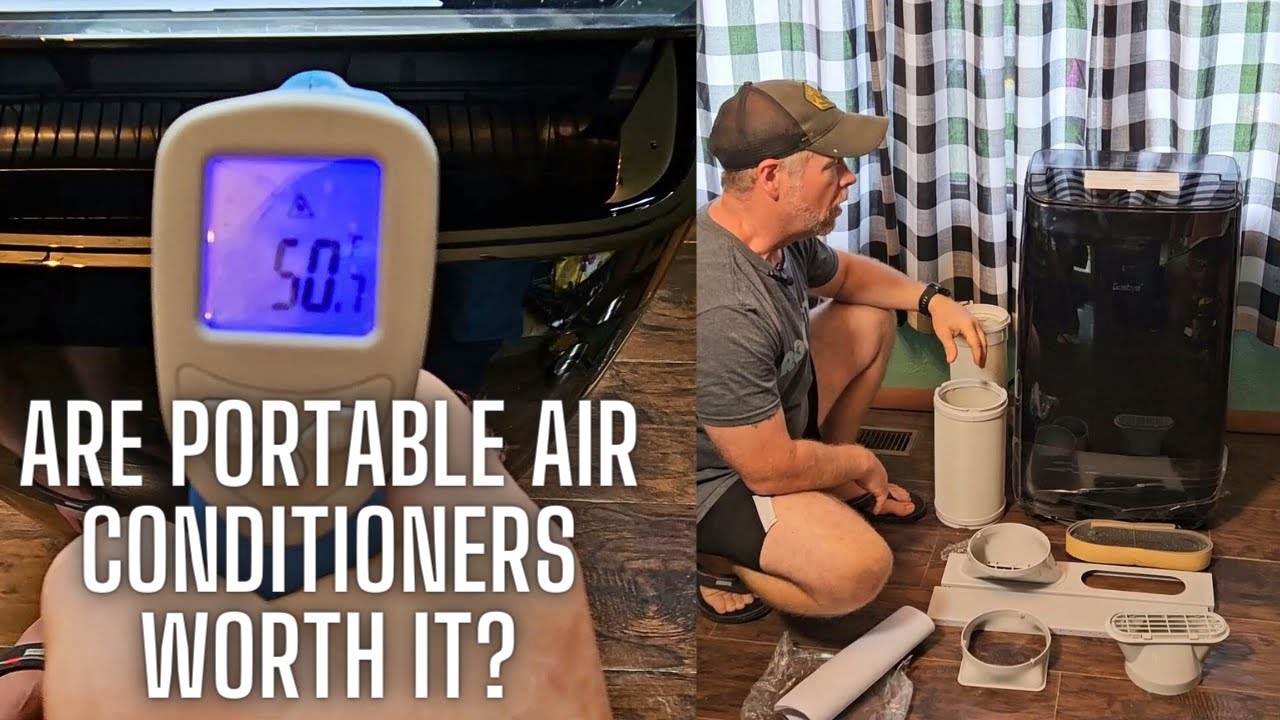

Gasbye Dual Hose Portable Air Conditioner Review
From Skinner's 100% Honest Reviews on YouTube
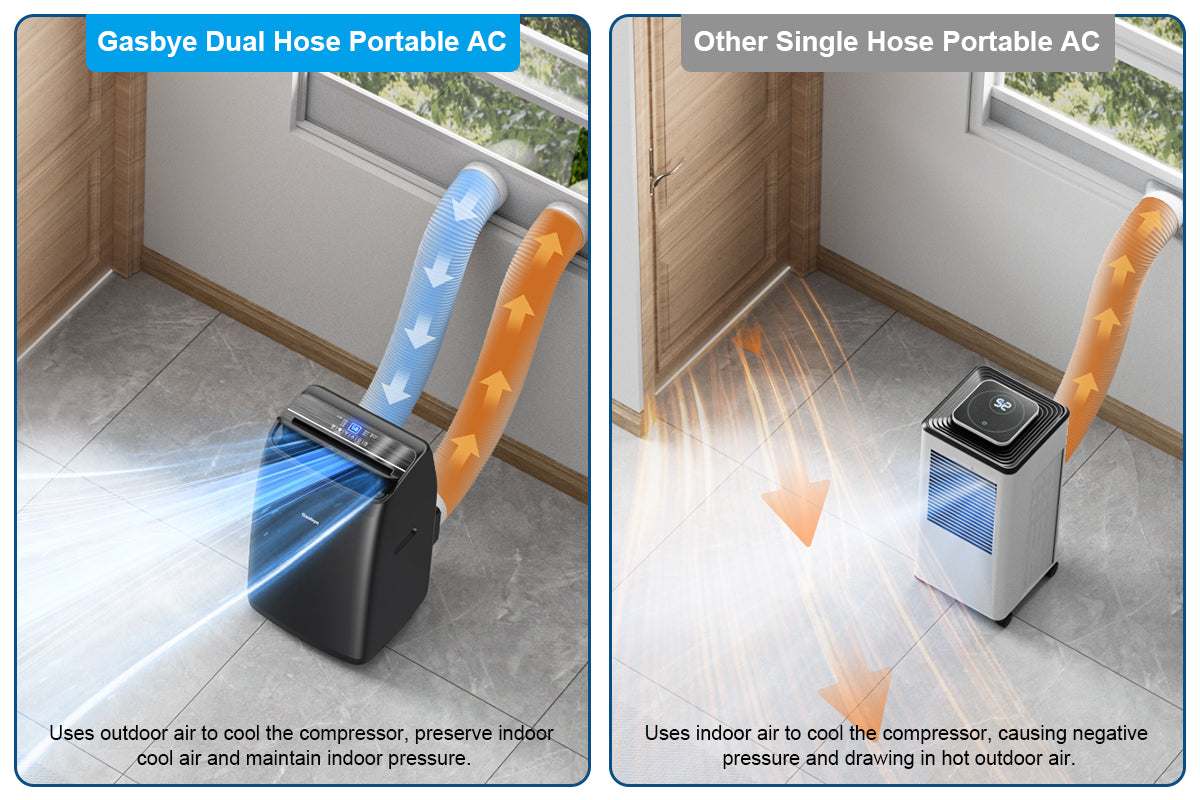
Dual Hose = Real Cooling
Dual hose systems are true air conditioners, capable of cooling an entire room. In contrast, single hose units create negative pressure indoors, causing hot outdoor air to be drawn in through door cracks and window gaps, making it feel like you're cooling with an open door or window.
Cools 50% faster than Single Hose design
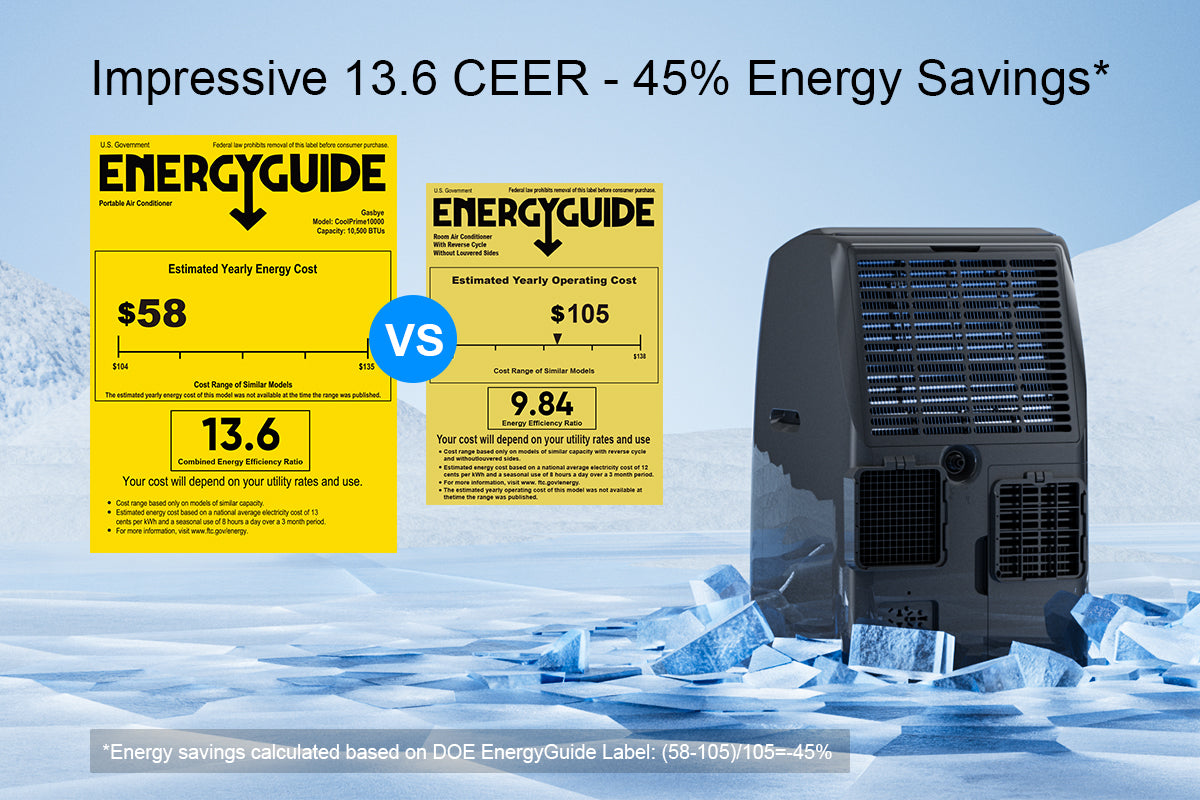
Not Inflated Specs
This 10,500 BTU SACC(14000 BTU ASHRAE 128) portable air conditioner, suitable for cooling room up to 500 Sq.Ft., boasts a 13.6 CEER rating verified by DOE, representing the pinnacle of energy efficiency in its market.
Peak Efficiency with Full DC Inverter Tech
Since we don’t inflate our BTU rating, this unit may be larger than some so-called “mini” models that falsely claim 14,000 BTU. Dimensions: 15.5" D × 17.7" W × 29.3" H — please ensure your space can accommodate this true 14,000 BTU unit.
In portable ACs, the main noise source is the compressor, not the fan. With our inverter compressor, that noise is greatly reduced. But if you're extremely sensitive to sound, even the quietest inverter portable AC may still be noticeable. For near-silent cooling, a split AC with an outdoor compressor is a better choice.
Cool every corner of your home
Tech specs
Performance
Features
General
Warranty
User Manual
Click to View Online: CoolPrime 10000
Included in the Box

CoolPrime-10000-B * 1
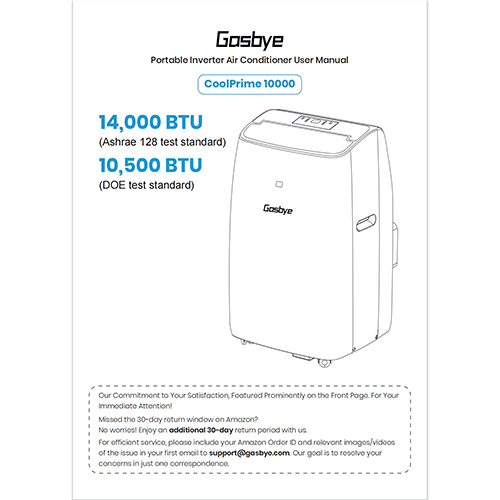
User Manual * 1
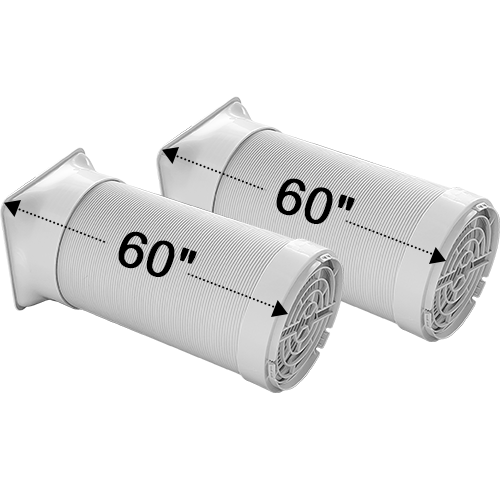
Air Exhaust and intake Hoses * 1
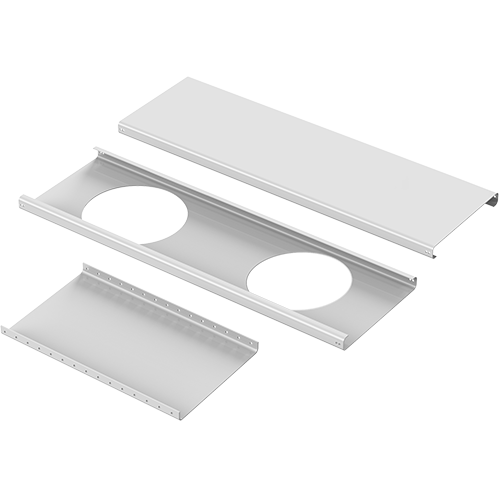
Window Bracket * 3
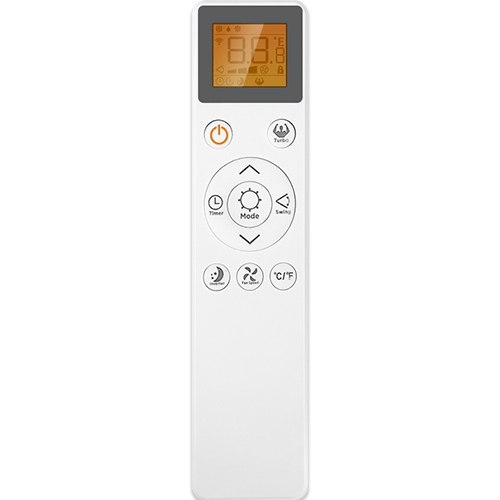
Remote Control * 1
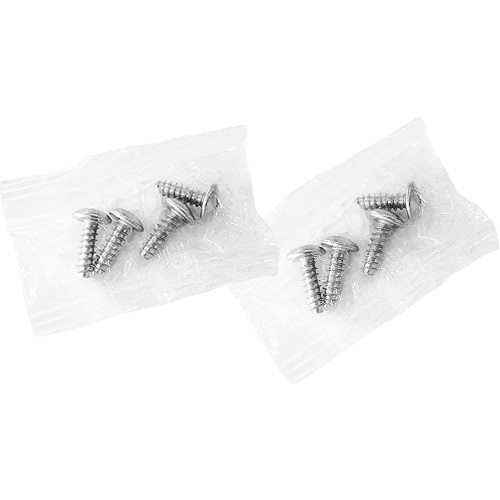
Metal Locking Screw * 8
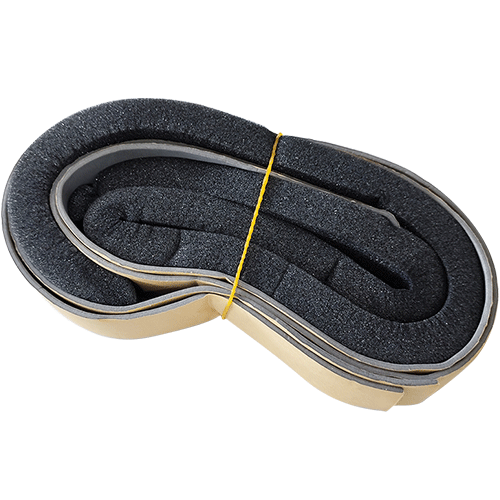
Adhesive Foam Seal * 2 and Non-adhesive Foam Seal * 1
FAQs - Dual hose portable AC
For product issues, please visit our Troubleshooting page.
What is the difference between dual-hose and single-hose portable air conditioners?
Single-hose units are a cost-cutting design and work more like a fan that blows cool air, only cooling the area directly in front of the unit. They create negative pressure indoors, drawing hot outdoor air in through door cracks and window gaps, making it feel like you're cooling with an open door or window. Dual-hose systems, with two separate air circulation pathways, are true air conditioners that can cool the entire room efficiently and are more energy-efficient.
What does "inverter" mean, and what are the advantages compared to non-inverter units?
Non-inverter units can only adjust fan speed, which changes fan noise but not the constant buzz of the compressor. At low fan speeds, the fan noise decreases, but the compressor noise becomes more noticeable and annoying. Inverter ACs let you lower both fan speed and compressor frequency, reducing both types of noise for a more comfortable experience. Another advantage of inverter ACs is that they are more energy-efficient. Your room doesn’t need the same cooling power all the time. During the day, when it’s hotter, you need stronger cooling — which uses more energy. But at night, when it’s cooler, less power is needed to stay comfortable. Inverter ACs let you manually adjust cooling power to match the room’s needs — use Turbo mode for fast cooling during the day, and Inverter mode at night to save energy. Fixed-speed ACs always run at full power, even when it’s not necessary — wasting electricity, especially at night.
Does the Gasbye dual-hose inverter portable air conditioner require drainage in high humidity?
In most cases, portable ACs do not require manual drainage. But if the humidity is over 85% RH and the room isn’t sealed, moisture from outside can 𝗰𝗼𝗻𝘁𝗶𝗻𝘂𝗼𝘂𝘀𝗹𝘆 𝗲𝗻𝘁𝗲𝗿, which may exceed the unit’s auto-evaporation capacity and require manual drainage. In such cases, unlike many portable ACs with drainage outlets at the bottom, our unit includes an additional drainage outlet positioned higher on the back, making the process much easier.
What do the 14,000 BTU (ASHRAE 128) and 10,500 BTU (SACC) ratings mean for the Gasbye Dual Hose Portable AC?
The cooling capacity of an air conditioner is influenced by the current temperature; the higher the temperature, the greater the challenge for the unit. ASHRAE 128 measures cooling capacity at 80°F, while SACC uses higher temperatures and stricter conditions, making it a more realistic measure of performance. Therefore, the SACC rating is usually lower but provides a more accurate assessment of the unit’s cooling efficiency in real-world conditions. Even for units rated at 14,000 BTU under ASHRAE 128, their SACC ratings can vary significantly. Since we don’t inflate the BTU rating of our unit, its size may be larger compared to some other "mini" models that falsely advertise 14,000 BTU. Its dimensions are 15.5" D x 17.7" W x 29.3" H
How long are the window brackets included with the Gasbye portable AC? What if my window is longer?
The portable AC package includes two 20-inch window brackets and one 10-inch window bracket. If your window is larger, don’t worry. After receiving your portable AC, you can request additional window brackets for 𝗙𝗥𝗘𝗘.



